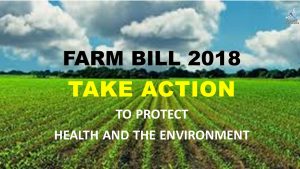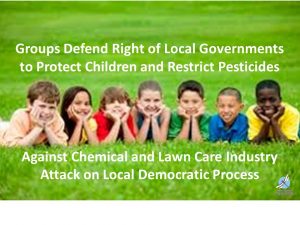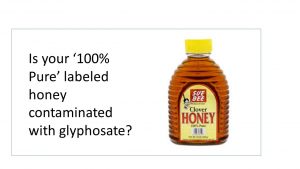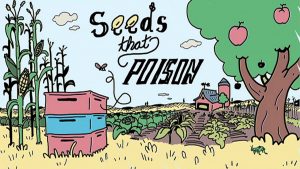27
Jun
Clean Up the Farm Bill, Protect Organic
 (Beyond Pesticides, June 27, 2018)
(Beyond Pesticides, June 27, 2018)
Farm Bill Headed for a Showdown on Key Environmental, Public Health, and Organic Issues
With a flawed bipartisan Farm Bill expected to sail through the U.S. Senate this week, we need to turn our attention to the upcoming House-Senate Conference Committee that will attempt to resolve differences between the Republican House bill (with no support from Democrats) and the Senate bill. Despite some advances in the Senate Farm Bill for the organic market, including boosts to organic research funding, some provisions to address fraudulent imports, some enhanced conservation programs, and maintaining certification cost-share programs, the Senate bill contains troubling language affecting organic standard setting that could open the door to more damaging provisions in the House bill. Itâs like fixing up a house while allowing the foundation to crumble.
Beyond Pesticides opposes any provisions in the Farm Bill that amend the standard setting procedures of the federal organic law and believes that no improvements are worth the damage that can be done to the standard setting process and public trust in the organic seal in the marketplace. Beyond Pesticides is urging that conferees in House-Senate Farm Bill conference committee over the next weeks to eliminate amendments that change any aspect of organic standard setting under the Organic Foods Production Act (OPFA).
The Farm Bill passed by the U.S. House of Representatives, H.R. 2, is a direct attack on: organic standard setting; the authority of local governments to restrict toxic pesticides; and, the protection of farmworkers, endangered species, and the environment. Now, the Senate is getting ready to pass a bill that opens the door to an attack on organic. While the Senate train is speeding down the track, it is important to keep these damaging provisions out of the final (conference) bill.
Protect Organic Standards. The Organic Foods Production Act (OFPA) gives the National Organic Standards Board (NOSB) broad authority and responsibility to ensure organic integrity. The House version of the Farm Bill contains provisions that will give USDA greater direct and indirect power to allow products and practices that were not intended to be a allowed in organic â hydroponics, poultry houses without real access to the outdoors, and dairy operations without meaningful pasture. The Senate bill opens up the dangerous possibility of a change to the organic standard setting process. There should be no changes to the process that establishes organic standards in order to protect the meaning and value of organic in the marketplace.
The Farm Bill should not:
- Change definitions that open OFPA to new interpretations of its core standard setting practices, which ensure rigorous review of synthetic substances in organic production and processing;
- Permit the U.S. Department of Agriculture (USDA) to sidestep the NOSB in allowing toxic post-harvest handling substances (sanitizers) to be used in organic production;
- Change the classification of types of people who may be appointed to the NOSB by adding employees of farmers, handlers, and retailers; and
- Force consideration of allowing the use of products in organic that are subject to weaker standards of the Food and Drug Administration (FDA) and the Environmental Protection Agency (EPA).
The Farm Bill should also not contain provisions that:
- Amend the federal pesticide law to preempt local governments from restricting pesticide use on private property within their jurisdictions;
- Exempt the use of pesticides from the Endangered Species Act, effectively dooming hundreds of endangered species to extinction and making it legal to kill any endangered species with a pesticide at almost any time;
- Eliminate litigation as a remedy when pesticide decisions threaten endangered species;
- Eliminate all protections under the Clean Water Act when toxic pesticides are sprayed directly into rivers and streams;
- Enact the Pesticide Registration Improvement Act, providing long-term funding to EPA for expedited processing of pesticide approvals, without accompanying measures to ensure that farmworkers and other pesticide applicators are safe;
- Weaken restrictions on the use of the highly toxic ozone deplete, methyl bromide; and
- Give states the authority to delay federal restrictions.
We encourage you to customize this message to maximize its impact.
Letter to Senators and Representatives:
Subject: Protect Organic and Environmental Standards in the Farm Bill
 In view of the anticipated passage of the Senateâs Farm Bill, Congress will soon be facing a daunting task of rectifying two very different bills. I urge you to take all possible steps to ensure that the final bill supports organic agriculture and environmental protections and does not interfere with organic standard setting.
 The Farm Bill should not:
- Change definitions that open OFPA to new interpretations of its core standard setting practices, which ensure rigorous review of synthetic substances in organic production and processing;
- Permit the U.S. Department of Agriculture (USDA) to sidestep the National Organic Standards Board (NOSB) in allowing toxic post-harvest handling substances (sanitizers) to be used in organic production;
- Change the classification of types of people who may be appointed to the NOSB by adding employees of farmers, handlers, and retailers; and
- Force consideration of allowing the use of products in organic that are subject to weaker standards of the Food and Drug Administration (FDA) and the Environmental Protection Agency (EPA).
 The Farm Bill should also not contain provisions that:
- Amend the federal pesticide law to pre-empt local governments from restricting pesticide use on private property within their jurisdictions;
- Exempt the use of pesticides from the Endangered Species Act, effectively dooming hundreds of endangered species to extinction and making it legal to kill any endangered species with a pesticide at almost any time;
- Eliminate litigation as a remedy when pesticide decisions threaten endangered species;
- Eliminate all protections under the Clean Water Act when toxic pesticides are sprayed directly into rivers and streams;
- Enact the âPesticide Registration Improvement Act,â providing long-term funding to EPA for expedited processing of pesticide approvals, without accompanying measures to ensure that farmworkers and other pesticide applicators are safe;
- Weaken restrictions on the use of the highly toxic ozone depleter, methyl bromide; and
- Give states the authority to delay federal restrictions.
 Sincerely,









 (Beyond Pesticides, June 25, 2018) Ten organizations filed an Amicus brief last week in support of a 2015 landmark Montgomery County, Maryland ordinance that restricts the use of toxic pesticides on public and private land within its jurisdiction. The law, intended to protect children, pets, wildlife, and the wider environment from the hazards of lawn and landscape pesticide use, is on appeal from a Circuit Court ruling in August 2017 which struck down aspects of the ordinance that apply to private property. The Montgomery County Council decided to appeal the Circuit Court ruling based on an outpouring of public support, and the advice of its legal team that the County has a reasonable chance of prevailing. The case will now be heard in front of the Court of Special Appeals of Maryland.
(Beyond Pesticides, June 25, 2018) Ten organizations filed an Amicus brief last week in support of a 2015 landmark Montgomery County, Maryland ordinance that restricts the use of toxic pesticides on public and private land within its jurisdiction. The law, intended to protect children, pets, wildlife, and the wider environment from the hazards of lawn and landscape pesticide use, is on appeal from a Circuit Court ruling in August 2017 which struck down aspects of the ordinance that apply to private property. The Montgomery County Council decided to appeal the Circuit Court ruling based on an outpouring of public support, and the advice of its legal team that the County has a reasonable chance of prevailing. The case will now be heard in front of the Court of Special Appeals of Maryland. (Beyond Pesticides, June 22, 2018) Mosquito misters pose a threat to human health. They also harm bees and other flying pollinators and are the least effective way to deal with biting mosquitoes. These devices are typically placed outdoors and spray insecticides âmostly in an attempt to control mosquitoes. In May, the Connecticut state legislature
(Beyond Pesticides, June 22, 2018) Mosquito misters pose a threat to human health. They also harm bees and other flying pollinators and are the least effective way to deal with biting mosquitoes. These devices are typically placed outdoors and spray insecticides âmostly in an attempt to control mosquitoes. In May, the Connecticut state legislature  (Beyond Pesticides, June 21, 2018) In a letter sent by the Center for Biological Diversity (CBD), the U.S. Fish and Wildlife Service (FWS) is being urged to complete status reviews and listing proposals for 23 wildlife species in the Southeast that are at risk of extinction. Citing deep concerns about unprecedented assaults on the Endangered Species Act (ESA), the letter reiterates the critical need for FWS to provide timely protection to the most critically imperiled species.
(Beyond Pesticides, June 21, 2018) In a letter sent by the Center for Biological Diversity (CBD), the U.S. Fish and Wildlife Service (FWS) is being urged to complete status reviews and listing proposals for 23 wildlife species in the Southeast that are at risk of extinction. Citing deep concerns about unprecedented assaults on the Endangered Species Act (ESA), the letter reiterates the critical need for FWS to provide timely protection to the most critically imperiled species. (Beyond Pesticides, June 20, 2018) Bumblebee queens that wake up from hibernation to a neonicotinoid-contaminated, monofloral landscape take longer to set up their nest and die-off at higher rates, according to new
(Beyond Pesticides, June 20, 2018) Bumblebee queens that wake up from hibernation to a neonicotinoid-contaminated, monofloral landscape take longer to set up their nest and die-off at higher rates, according to new  (Beyond Pesticides, June 19, 2018)Â Some 200 members of a
(Beyond Pesticides, June 19, 2018)Â Some 200 members of a 
 (Beyond Pesticides, June 14, 2018) With nearly 40% of Americans diagnosed as clinically obese, leading to health care costs estimated at over $200 billion, researchers are focusing on ways individuals can reduce their exposure to chemicals that contribute to weight gain regardless of diet or exercise. These chemicals, known as âobesogens,â include a range of consumer products, from pesticides to plastics and flame retardants. While diet and exercise remain critically important to fighting the ongoing obesity epidemic, obesogens may be working to increase appetite, fat storage, or make it more difficult for the body to shed fat once it is gained.
(Beyond Pesticides, June 14, 2018) With nearly 40% of Americans diagnosed as clinically obese, leading to health care costs estimated at over $200 billion, researchers are focusing on ways individuals can reduce their exposure to chemicals that contribute to weight gain regardless of diet or exercise. These chemicals, known as âobesogens,â include a range of consumer products, from pesticides to plastics and flame retardants. While diet and exercise remain critically important to fighting the ongoing obesity epidemic, obesogens may be working to increase appetite, fat storage, or make it more difficult for the body to shed fat once it is gained. (Beyond Pesticides, June 13, 2018) On June 6, 2018, the New York State Department of Environmental Conservation (NYSDEC) released its final policy for the disclosure of cleaning product ingredients under its Household Cleansing Product Information Disclosure Program. The program will require full disclosure of ingredients on product labels or manufacturer website for all products sold in the state, as well as the identification of chemicals of concern. NYSDEC states the program is intended to protect consumers from harmful chemicals in household products.
(Beyond Pesticides, June 13, 2018) On June 6, 2018, the New York State Department of Environmental Conservation (NYSDEC) released its final policy for the disclosure of cleaning product ingredients under its Household Cleansing Product Information Disclosure Program. The program will require full disclosure of ingredients on product labels or manufacturer website for all products sold in the state, as well as the identification of chemicals of concern. NYSDEC states the program is intended to protect consumers from harmful chemicals in household products. (Beyond Pesticides, June 11, 2018)Â Â With
(Beyond Pesticides, June 11, 2018)Â Â With  (Beyond Pesticides, June 8, 2018)Â In the wake
(Beyond Pesticides, June 8, 2018)Â In the wake  (Beyond Pesticides, June 7, 2018) Health Canada is proposing to phase out a number of uses of neonicotinoids in order to mitigate risks to pollinators. The agency has completed its review of clothianidin and thiamethoxam — two neonicotinoids that have been linked to pollinator decline and finds risks of concern for bees. However, these measures do not go as far as those recently made in the European Union, but further than label restrictions issued by the U.S. Environmental Protection Agency (EPA).
(Beyond Pesticides, June 7, 2018) Health Canada is proposing to phase out a number of uses of neonicotinoids in order to mitigate risks to pollinators. The agency has completed its review of clothianidin and thiamethoxam — two neonicotinoids that have been linked to pollinator decline and finds risks of concern for bees. However, these measures do not go as far as those recently made in the European Union, but further than label restrictions issued by the U.S. Environmental Protection Agency (EPA). (Beyond Pesticides, June 6, 2018)Â By the close of 2018, three top neonicotinoid (neonic) pesticides, linked to the worldwide decline in bee populations, will be banned for outdoor use in the European Union (EU), based on the
(Beyond Pesticides, June 6, 2018)Â By the close of 2018, three top neonicotinoid (neonic) pesticides, linked to the worldwide decline in bee populations, will be banned for outdoor use in the European Union (EU), based on the  (Beyond Pesticides, June 5, 2018) After more than 100,000 Swiss citizens signed a petition calling for a ban on pesticides, Switzerland will soon have to vote on a complete ban on the use of synthetic pesticides. The ban would apply to farmers, industries, and imported goods, and advocates hope this measure would cause other EU nations to follow.
(Beyond Pesticides, June 5, 2018) After more than 100,000 Swiss citizens signed a petition calling for a ban on pesticides, Switzerland will soon have to vote on a complete ban on the use of synthetic pesticides. The ban would apply to farmers, industries, and imported goods, and advocates hope this measure would cause other EU nations to follow.
 (Beyond Pesticides, June 1, 2018) States and civil society organizations launched new lawsuits in late May against the Pruitt Environmental Protection Agency (EPA) for its continued attack against farmworker health and safety. Two separate lawsuits, one filed by attorneys general in the states of California, Maryland, and New York, and another by health and justice advocates represented by Earthjustice and Farmworker Justice take aim at EPAâs decision to delay the implementation of training requirements designed to protect farmworkers and their families. This is the latest in a series of lawsuits which began when EPA announced
(Beyond Pesticides, June 1, 2018) States and civil society organizations launched new lawsuits in late May against the Pruitt Environmental Protection Agency (EPA) for its continued attack against farmworker health and safety. Two separate lawsuits, one filed by attorneys general in the states of California, Maryland, and New York, and another by health and justice advocates represented by Earthjustice and Farmworker Justice take aim at EPAâs decision to delay the implementation of training requirements designed to protect farmworkers and their families. This is the latest in a series of lawsuits which began when EPA announced  (Beyond Pesticides, May 31, 2018)Â Deforestation in tropical regions helps spread malaria, concludes a
(Beyond Pesticides, May 31, 2018)Â Deforestation in tropical regions helps spread malaria, concludes a  (Beyond Pesticides, May 30, 2018) Six environmental groups have sued the Trump Administration for reversing a long standing interpretation of the Migratory Bird Treat Act (MBTA) that provides migratory bird protections from incidental killing or “taking” caused by industrial activities. The lawsuit,
(Beyond Pesticides, May 30, 2018) Six environmental groups have sued the Trump Administration for reversing a long standing interpretation of the Migratory Bird Treat Act (MBTA) that provides migratory bird protections from incidental killing or “taking” caused by industrial activities. The lawsuit,  (Beyond Pesticides, May 29, 2018)Â The Farm Bill is beginning to move in the U.S. Senate Committee on Agriculture, Nutrition, and Forestry, and your voice is critically needed to help stop provisions that are harmful to health and the environment.
(Beyond Pesticides, May 29, 2018)Â The Farm Bill is beginning to move in the U.S. Senate Committee on Agriculture, Nutrition, and Forestry, and your voice is critically needed to help stop provisions that are harmful to health and the environment. (Beyond Pesticides, May 25, 2018) The results of a pilot study conducted by an international team of researchers finds that exposure to the
(Beyond Pesticides, May 25, 2018) The results of a pilot study conducted by an international team of researchers finds that exposure to the 
